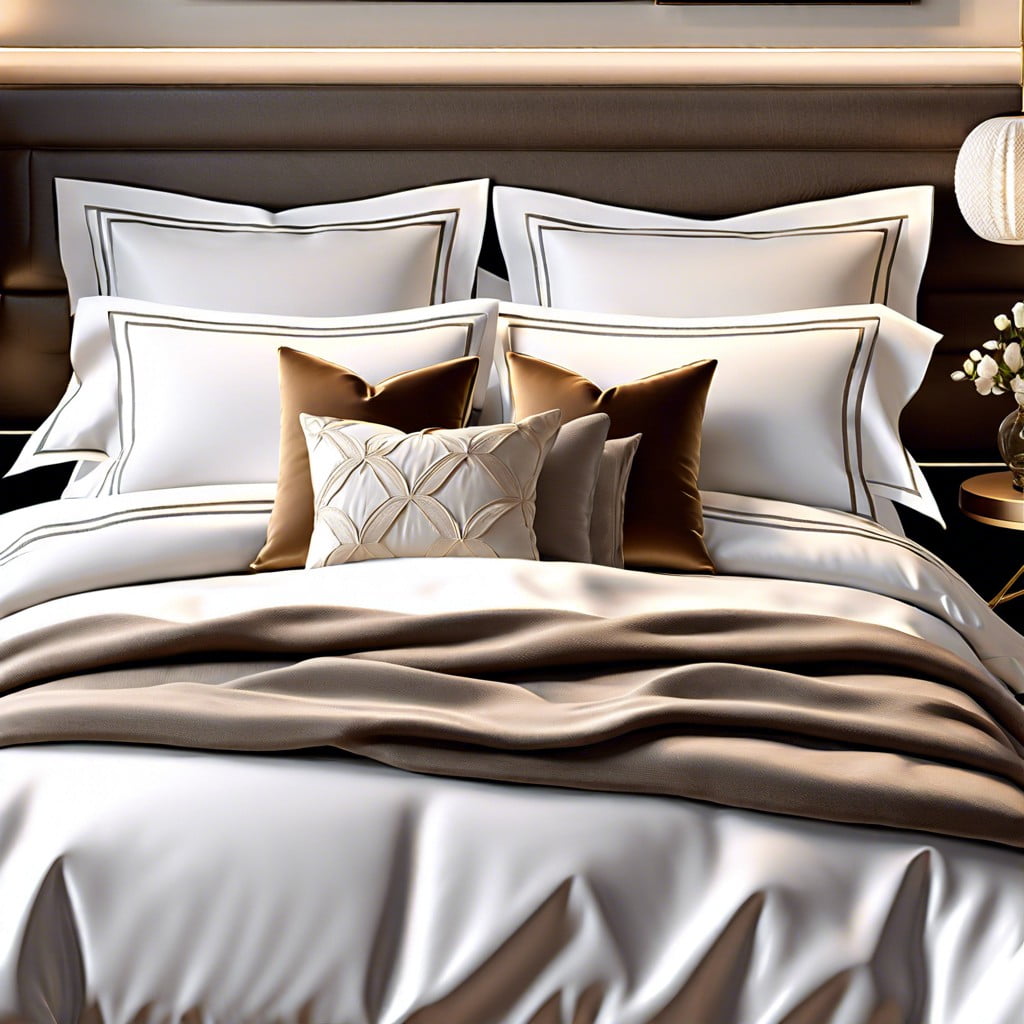Discover the key ingredients for creating a serene sleep oasis as we guide you through selecting the perfect bedding for your needs.
Key takeaways:
- Thread count isn’t the only factor in sheet quality.
- Explore different materials for bedding: cotton, linen, silk, etc.
- Choose fill materials for comforters and pillows that suit your needs.
- Color and pattern selection can set the mood in your bedroom.
- Follow proper care and maintenance tips to keep your bedding luxurious.
Understanding Thread Count and Its Impact On Quality

Diving straight into the fine weave of the matter, think of thread count as the number of threads woven together in a square inch of fabric. It’s a cozy little fact that the higher the thread count usually points to a smoother and more durable sheet. However, don’t be fooled by numbers alone. A thread count ranging between 200-800 is generally a sweet spot for both comfort and strength.
But hold your horses before you race to the highest number. There’s a twist in the thread tale: incredibly high thread counts can actually mean a denser sheet, which might not be the breath of fresh air you’re looking for in the heat of summer nights.
Material matters too. A lower thread count in a high-quality cotton like Egyptian or Pima can feel like a cloud nine, beating out a higher thread count in a run-of-the-mill fabric.
Remember, it’s not just about the count; it’s the quality of the dance between threads that creates the perfect backdrop for your slumberland solos. So next time you’re sheet shopping, play detective and look beyond the numbers—your dreamy sleep depends on it.
Exploring Different Bedding Materials: Cotton, Linen, Silk, and More
Cotton stands as a go-to for comfort and breathability, with its myriad of weaves offering distinct feels. Percale grants a crisp, cool touch ideal for warm sleepers, while sateen provides a buttery softness with a slight sheen. Organic varieties stand out for eco-conscious buyers prioritizing sustainability without compromising on comfort.
Linen, made from flax fibers, brings a relaxed, lived-in look to the table. Exceptionally strong and inherently moisture-wicking, this material excels in hot climates and gets softer with each wash. Plus, its casual elegance whispers rather than shouts luxury.
Silk, the epitome of smooth, glides into luxury territory with its hypoallergenic properties—a boon for sensitive skin. The material’s natural proteins help keep hair smooth and skin soft, all while regulating temperature to cocoon sleepers in year-round comfort.
And then there are the newcomers: bamboo and Tencel. Bamboo’s claim to fame is its softness paired with eco-friendliness, making it a darling for the environmentally attuned. Tencel, from wood cellulose, shines with a drape as graceful as silk and moisture management that rivals linen—ideal for a restful night’s sleep.
Each fabric carries a distinct character and comfort profile. Consider personal sleep preferences and values, be it the cool caress of percale or the earth-friendly embrace of bamboo, to find the dreamiest match for your slumber sanctuary.
Choosing the Right Fill Material for Comforters and Pillows
Dive into down or feathers for a sumptuous sleep experience. These materials offer superior warmth and a cloud-like feel but can trigger allergies in some. For the allergy-prone, synthetic alternatives like microfiber provide comfort without the sneezes, striking a balance between softness and hypoallergenic properties.
Memory foam stands at the forefront for pillows, conforming to head and neck contours for tailored support. However, its density might not appeal to everyone. Those craving a plush, hotel-like indulgence might lean towards latex, which offers a firm yet buoyant sensation.
Natural choices such as wool or bamboo represent brilliance in temperature regulation. Wool, with its moisture-wicking capabilities, keeps you cool in summer and toasty in winter. Bamboo, apart from being sustainable, feels breathable and stays refreshingly cool against the skin.
Lastly, buckwheat hulls are the unsung heroes of pillow fills. Their firm structure supports spinal alignment impeccably, although their rustling might take a night or two to get accustomed to.
Remember, the loft and firmness are not just about personal comfort; they’re pivotal for spinal alignment during sleep. A simple test is the goldilock’s approach when selecting pillows—if it feels ‘just right,’ you’re on the right track.
Color and Pattern Selection to Set the Bedroom Mood
Dive into the world of hues and designs — your bedroom’s ambiance hinges on these choices. Soft pastels like baby blue and light pink tend to create a serene oasis, ideal for unwinding after a long day. Bold colors like emerald green or royal blue, on the other hand, infuse a touch of drama and luxury.
Patterns play equally pivotal roles. Large geometrics give a modern twist, while florals bring a whiff of tradition and an outdoor feel to any bedroom. Stripes? They’re the go-to for a nautical, preppy vibe — think of them as the crisp white shirt of the bedding world.
But don’t just throw caution to the wind. Consider the size of your room. Smaller spaces generally benefit from simpler patterns or solid colors to avoid a cluttered look. For expansive rooms, feel free to experiment with bolder, more intricate patterns that fill the space with character.
Remember, balance is key. If your walls are adorned with lively wallpaper, let your bedding be the calm within the storm with muted tones. Conversely, let vibrant bedding take center stage against a backdrop of neutral walls. It’s all about creating harmony that sings you to sleep.
Caring for Your Bedding: Washing and Maintenance Tips
Smooth, crisp sheets and plush comforters offer more than just a good night’s rest; they’re the secret agents of bedroom luxury. But like any undercover ally, they need regular upkeep to keep their performance top-notch. Let’s talk tips:
Wash sheets weekly—easier said than done, but think of sliding into freshness as the weekly reward for this habit. Use mild detergent, and for heaven’s sake, cool water. Hot water is the arch-nemesis of bedding lifespan, causing shrinking and color fading faster than a villain in a spy movie.
Pillows have a trick up their sleeve too. A bimonthly spin in the machine keeps them fluffy. Just make sure they’re thoroughly dry; damp pillows are as unwelcome as a wet blanket at a picnic.
Comforters are a different kettle of fish; they don’t need a spin as often. Two to three times a year should suffice unless a breakfast-in-bed mishap dictates otherwise.
And for the pièce de résistance, ironing. It might sound over the top, but ironed sheets are the secret handshake of quiet luxury. Plus, the heat can help zap lingering germs.
Remember, care labels are your roadmaps; they navigate you through the washing terrain without taking a wrong turn. Treat them like the treasure maps they are.
Give your bedding the TLC it deserves, and every night can feel like a luxury staycation. Keep it clean, folks, and the Zs will follow.





